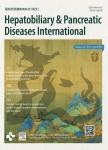Computed tomography radiomic features and clinical factors predicting the response to first transarterial chemoembolization in intermediate-stage hepatocellular carcinoma
作者机构:Department of Interventional Radiologythe Second Affiliated Hospital of Harbin Medical UniversityHarbin 150086China Department of Digestive MedicineDaqing Longnan HospitalDaqing 163453China Department of RadiologyDaqing Longnan HospitalDaqing 163453China Department of Radiologythe Second Affiliated Hospital of Harbin Medical UniversityHarbin 150086China
出 版 物:《Hepatobiliary & Pancreatic Diseases International》 (国际肝胆胰疾病杂志(英文版))
年 卷 期:2024年第23卷第4期
页 面:361-369页
核心收录:
学科分类:1002[医学-临床医学] 100214[医学-肿瘤学] 10[医学]
基 金:Harbin Medical University, HMU, (KY2019–217) Harbin Medical University, HMU
主 题:Hepatocellular carcinoma Transarterial chemoembolization Radiomics Treatment response Prediction
摘 要:Background:According to clinical practice guidelines,transarterial chemoembolization(TACE)is the standard treatment modality for patients with intermediate-stage hepatocellular carcinoma(HCC).Early prediction of treatment response can help patients choose a reasonable treatment plan.This study aimed to investigate the value of the radiomic-clinical model in predicting the efficacy of the first TACE treatment for HCC to prolong patient survival.Methods:A total of 164 patients with HCC who underwent the first TACE from January 2017 to September 2021 were analyzed.The tumor response was assessed by modified response evaluation criteria in solid tumors(mRECIST),and the response of the first TACE to each session and its correlation with overall survival were evaluated.The radiomic signatures associated with the treatment response were identified by the least absolute shrinkage and selection operator(LASSO),and four machine learning models were built with different types of regions of interest(ROIs)(tumor and corresponding tissues)and the model with the best performance was selected.The predictive performance was assessed with receiver operating characteristic(ROC)curves and calibration curves.Results:Of all the models,the random forest(RF)model with peritumor(+10 mm)radiomic signatures had the best performance[area under ROC curve(AUC)=0.964 in the training cohort,AUC=0.949 in the validation cohort].The RF model was used to calculate the radiomic score(Rad-score),and the optimal cutoff value(0.34)was calculated according to the Youden’s index.Patients were then divided into a high-risk group(Rad-score0.34)and a low-risk group(Rad-score≤0.34),and a nomogram model was successfully established to predict treatment response.The predicted treatment response also allowed for significant discrimination of Kaplan-Meier curves.Multivariate Cox regression identified six independent prognostic factors for overall survival,including male[hazard ratio(HR)=0.500,95%confidence interval(CI):0.260–0.962,P=0.038],alpha-fetoprotein(HR=1.003,95%CI:1.002–1.004,P0.001),alanine aminotransferase(HR=1.003,95%CI:1.001–1.005,P=0.025),performance status(HR=2.400,95%CI:1.200–4.800,P=0.013),the number of TACE sessions(HR=0.870,95%CI:0.780–0.970,P=0.012)and Rad-score(HR=3.480,95%CI:1.416–8.552,P=0.007).Conclusions:The radiomic signatures and clinical factors can be well-used to predict the response of HCC patients to the first TACE and may help identify the patients most likely to benefit from TACE.



